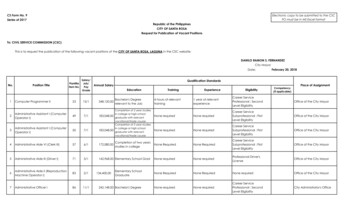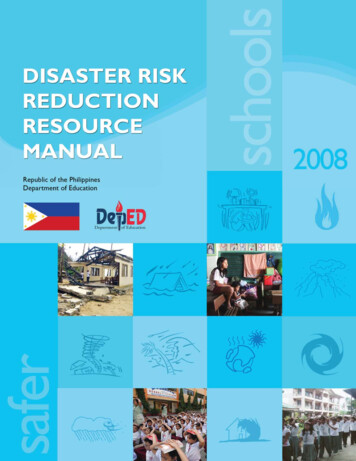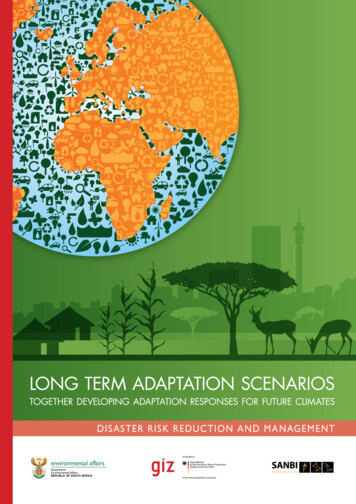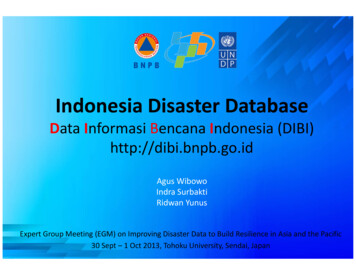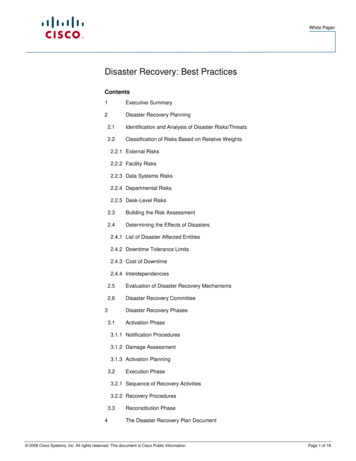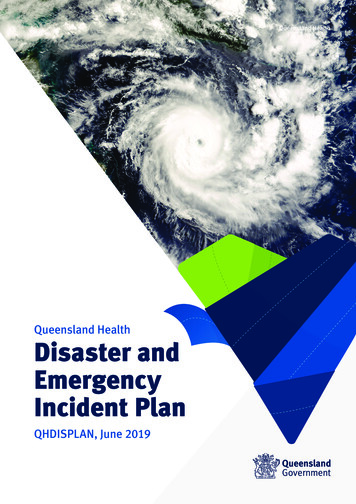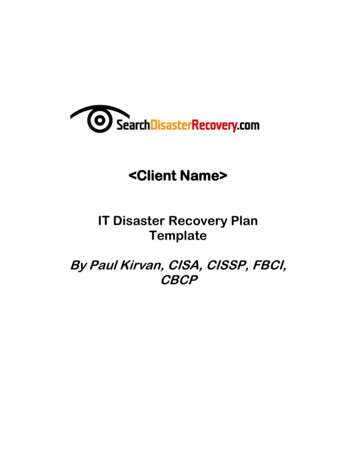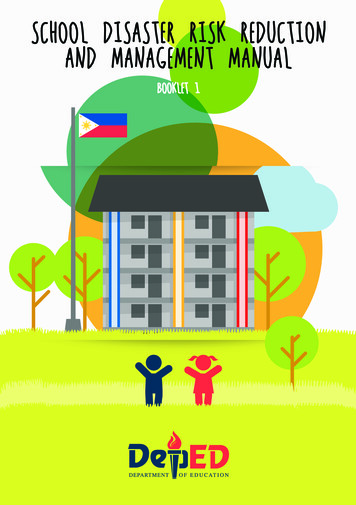
Transcription
School Disaster Risk Reductionand Management ManualBooklet 1
This School Disaster Risk Reduction and Management(DRRM) Manual has been developed by the Departmentof Education to serve as a common template forlocalization, contextualization, and adaptation at thesub-national context. It is expected that the content willbe reviewed by education and disaster managementauthorities, and education sector partners working ondisaster and risk reduction and who have adaptedpolicy and practices for the school environment.Booklet I
ACKNOWLEDGEMENTWe express our heartfelt appreciation to Undersecretary Reynaldo AntonioD. Laguda for his leadership in the development and publication of this Manual,and to the following:Contributors/WritersMariel C. BayangosPDO IV, Policy Research and Development DivisionMa. Vic S. RelaysonTechnical GuidanceRonilda CoDirector IV, DRRMSReviewersMs. Rachael Cristal FerminRisk Reduction and Resilience Education AdvisorSave the Children PhilippinesAnnaliza LayloConsultant, EiE and DRR in EducationUNICEF PhilippinesSchool Effectiveness Divisionunder the leadership of Dexter N. PanteDepartment of EducationiiProofreaderMa. Lourdes MarinasLayout ArtistLowil Fred Espada
FOREWORDThe Philippines is prone to multiple hazards. The education sector is one of themost vulnerable sectors during emergencies. It is among those that often sufferthe impacts of disasters brought about by natural and human-induced hazards.From our experience, we recognize that disasters deprive children of their rightto a continuous quality basic education in a safe environment. They threaten thelives of children, their families, and education personnel. Disasters also set backthe investments made by the education sector.Reducing disaster risks confronting the education sector is paramount to theachievement of the Department of Education’s (DepEd) outcomes, namely: access,quality, and governance. As such, the Department, as a member of the NationalDisaster Risk Reduction and Management Council (NDRRMC), has been building theresilience of education by advancing school safety. In accordance with this thrust,DepEd has created the Comprehensive DRRM in Basic Education Framework, whichunderscores the following three pillars or areas of focus: 1) Safe Learning Facilities;2) School Disaster Management; 3) DRR in Education. The ongoing implementationof these pillars is aligned with DepEd’s commitment to the four thematic areas ofthe Philippine DRRM Act of 2010, otherwise known as RA 10121. These areas arePrevention and Mitigation, Preparedness, Response, Recovery and Rehabilitation.To enable focused, effective and strategic implementation, DepEd has establishedthe office of the Disaster Risk Reduction and Management Service (DRRMS), withregular full time staff in its central, regional and division offices. The division officesare responsible for ensuring that schools have a functioning disaster managementteam.This School Disaster Risk Reduction and Management Manual provides guidanceto our division coordinators and schools in the implementation of the ComprehensiveDRRM in Basic Education Framework. This Manual explains the Framework andidentifies the tools to be used by the schools, with a particular focus on SchoolDisaster Management (Pillar 2). I call on our partners to likewise use the Manualto support the capacity building of our schools.I hope that this Manual will be beneficial in strengthening the safety andresilience of our schools nationwide.BR. ARMIN A. LUISTRO FSCSecretaryiii
ContentsBackground and Rationale2234School Hazards and RisksPurposeSOME IMPORTANT DEFINITIONSEnd UserThe Comprehensive DRRM in Basic Education Framework78Legal BasisSchool DRRM Implementation Support andMechanismsThe Three Pillars of the Comprehensive DRRM in BasicEducation14141415ivThe Three PillarsPillar I Safe Learning FacilitiesRisk Identification and AssessmentDefining a Conducive and Safe LearningEnvironment
161717171818181920202121212222Pillar II School Disaster ManagementLeadership and CoordinationInformation ManagementCore functions of the SDRRM TeamInformation Management ProtocolInformation Management Guide QuestionsSchool and Community Stakeholders’Engagement and ParticipationStudent-led ActivitiesStaff Training SupportEducation Continuity PlanPillar III Risk Reduction and ResilienceEducationDRRM Integration in the K to 12 CurriculumCo-Curricular ActivitiesLearning Materials and StrategiesNational Greening Programv
Backgroundand RationaleDisasters deprive children of their rightto a continuous, quality, basic educationin a safe environment. They threaten thelives of children, their families, andeducation personnel.
School Hazards and RisksFloods, tropical cyclones, and majorearthquakes, though not always as destructive,are the deadliest and costliest of hazards. Themost terrible consequences are deaths andinjuries in schools.There are schools that are unusable becauseof damages, their prolonged use as shelters,having unsafe access, the loss of equipment andmaterials, or lack of teachers are some effects ofhazards which can hinder children to achievetheir goals.From SY 2009/10 to 2013/14, top three hazardexposures of schools are tropical cyclones, floodand earthquake (DepEd EBEIS; 2009 – 2013). Insome cases, schools experience more than onehazard at one point in time. It should also benoted that schools are as well exposed to humaninduced hazards like armed conflict and fire at 7%and 2%, respectively DepEd EBEIS; 2009 – 2013).The accompanying risks from natural hazardscould be determined by the structural integrityof school buildings; awareness and capacity ofteachers and students; geographic location ofschools; population distribution; and institutionalsupport, among others.Hazards only become disasters when it affects a population.DidyouknowThe severity of the disaster depends on a population’s capacity to cope usingits own resources. Hazards that occur in an uninhabited island or hazardsthat occur in a community which is well prepared for such events may notexperience a disaster. Decreasing vulnerabilities and increasing capacities ofa community exposed to a hazard could prevent disasters.For further reading: DepEd Disaster Risk Reduction Manual (Safer School Resource Manual) 2008, UNConvention on the Rights of a Child, Sendai Framework, The Philippine Disaster Risk Reduction ManagementActPurposeMany risks associated with hazards can beavoided by the actions we take. This SchoolDisaster Risk Reduction and Management (DRRM)Manual is designed to guide school heads andadministrators in facilitating the protection ofchildren, education personnel, and educationitself.In addition, this Manual guides thedevelopment or improvement of existingpolicies, practices, protocols and plans at the2school level. The list of activities will serve asminimum guidance for schools to implementDRRM, which could enhance existing practicesor require new ones.This Manual is divided into two booklets.The first booklet covers the ComprehensiveDRRM in Basic Education Framework, includingthe institutional mechanisms that support it. Italso explains the three pillars of the Frameworkthat will guide the implementation of DRRM inschools. The second booklet provides practicalsteps and useful tools to operationalize DRRM
SOME IMPORTANT DEFINITIONSHazardA dangerous phenomenon, substance, human activity or condition thatmay cause loss of life, injury or other health impacts, property damage,loss of livelihoods and services, social and economic disruption, orenvironmental damage.DisasterA serious disruption of the functioning of a community or a societyinvolving widespread human, material, economic or environmentallosses and impacts, which exceeds the ability of the affected communityor society to cope using its own resources.Disaster RISKThe potential disaster losses, in lives, health status, livelihoods, assetsand services, which could occur to a particular community or a societyover some specified future time period.Disaster RISKREDUCTIONDisaster RISKMANAGEMENTThe concept and practice of reducing disaster risks through systematicefforts to analyze and manage the causal factors of disasters, includingthrough reduced exposure to hazards, lessened vulnerability of peopleand property, wise management of land and the environment, andimproved preparedness for adverse events.The systematic process of using administrative directives, organizations,and operational skills and capacities to implement strategies, policiesand improved coping capacities in order to lessen the adverse impactsof hazards and the possibility of disaster.Above definitions are from UNISDRRECOVERYDecisions and actions taken after a disaster with a view to restoring orimproving the pre-disaster living conditions of the stricken communitywhile encouraging and facilitating necessary adjustments to reducedisaster risks.PREPAREDNESSActivities and measures taken in advance to ensure effective responseto the impact of hazards, including the issuance of timely and effectiveearly warnings and the temporary evacuation of people and propertyfrom threatened locations.RESPONSEThe act of implementing or translating into actions what are called forby the preparedness plans. Response includes actions taken to savelives and prevent further damage in a disaster or emergency situation.Seeking shelter from strong winds accompanying a typhoon andevacuating to higher grounds due to an impending flood are examplesof response.These definitions are from the DepEd Disaster Risk Reduction Resource Manual3
in schools.End UserThis Manual is written for schooladministrators, school planning team (SPT) andschool DRRM team. It ensures that school headsand administrators are with standards on how toreduce risks and manage the effects of hazardsin their schools.It primarily supports the implementation ofschool-based management.4
5
The Comprehensive DRRMin Basic EducationFramework
Legal BasisThe implementation of DRRM in basiceducation is guided by DepEd’s three majoroutcomes—Access, Quality and Governance. Theseset the program and policy development agendaof the agency.As a member of the National DRRM Council(NDRRMC), the Department is also committedto implement DRRM in basic education withinthe following thematic areas: Prevention andMitigation; Preparedness; Response; and Recoveryand Rehabilitation.As shown in Figure 1, the translation of DepEd’scommitment to its mandate and to the NDRRMCis reflected in its Comprehensive DRRM in BasicEducation Framework which has been adaptedfrom the Global Comprehensive Safety Framework.DepEd’s framework provides guidance in:Theimplementation ofDRRM for educationpractitioners’ andpartners’ planning andprogramming at alllevels;The inclusionof DRRM in theschool, divisionand regionaleducationdevelopmentplans;Serving asmechanism forengaging partnersand aligning theirthrust to DepEdpriorities;ACCESSQUALITYGOVERNANCEDefiningthe agency’sresponseto hazardsaffecting schooloperations;Guidingcollaborationwith the privateschools.Prevention and MitigationPreparednessResponseRecovery and RehabilitationPillar 1Safe LearningFacilitiesPillar 2School DisasterManangementPillar 3DRR inEducationFIGURE 1 The Comprehensive DRRM in Basic Education Framework8
The Framework shows the interrelationshipbetween the global and national frameworks instrengthening the implementation of DRRM inbasic education.The Comprehensive DRRM in Basic EducationFramework seeks to:1. Protect learners and education workersfrom death, injury, and harm in schools;2. Plan for educational continuity in the faceof expected hazards and threats;3. Safeguard education sector investments; and4. Strengthen risk reduction and resiliencethrough educationWith the issuance of a policy (DO 37 s 2015),the Framework is expected to guide schools inassessing, planning and implementing theirspecific prevention and mitigation, preparedness,response and recovery and rehabilitationinterventions as expressed in the following:These three pillars form the bases onthe conduct of risk assessment which areincorporated in the education developmentplans of the regions, divisions, as well as in theschool improvement plans. These three pillarsare tackled in the next sectionPillar 1: Safe LearningFacilitiesSchool DRRM ImplementationSupport and MechanismsThe creation and upgrading of the DRRMservice in DepEd (DO 50 s 2011 and DM 112 s2015) institutionalized DRRM within the basiceducation system.Plantilla positions for DRRM Coordinatorswere created from national to division leveloffices to fully integrate DRRM policies andprograms at all levels. Coordination andinformation management protocols as well asroles and responsibilities have been defined fromschool to regional levels to ensure coherencewith the already existing structures and legalbases (DO 21 s 2015: DRRM Coordination andInformation Management Protocol).Schools, have established DRRM policiesand programs in support of the national,regional and divisions directions (RA 9155:Basic Education Governance Act of 2001).Specific interventions to address the effectsof hazards and risks are determined at theschool level. The School Planning Team (SPT)and the School DRRM Team (SDRRM Team) shallwork hand in hand to implement DRRM. Withinthese two school groups assessment, planning,implementation, monitoring, evaluation andreporting of DRRM interventions will be made.Pillar 2: School DisasterManagementPillar 3: Disaster Risk Reduction inEducation9
Based on DO 21 s 2015 the SDRRM Team will undertake the following:1. Ensure the establishment of an Early Warning System (i.e. bulletinboard for weather advisories, bell/siren emergency signal and thelike);2. Conduct an annual student-led risk identification and mappingwithin and around the school premises to ensure a safe environmentthat is conducive to teaching and learning;3. Maintain close coordination with local DRRM Council on the conductof preparedness activities and on response needs, among others;4. Provide capacity building activities for teachers, non-teaching staffand learners on DRRM;5. Maintain, disseminate, and post relevant and updated emergencyhotlines in strategic locations throughout the school;6. Post safety and preparedness measures and evacuation plans;7. Conduct disaster preparedness measures, including but not limitedto quarterly multi-hazard drills applicable to the school’s identifiedhazard such as earthquake, fire and flood;8. Maintain the safekeeping of vital school records and learningmaterials;10
9. Organize school DRRM team to support the implementation ofpreparedness and response measures;10. Ensure the availability of updated baseline education data of theschool;11. Integrate DRRM in regular school programs and activities and schoolimprovement plan (SIP);12. Pre-identify possible Temporary Learning Spaces (TLS) andalternative delivery modes of education;13. Monitor the effects of hazards, including the use of the school asevacuation center;14. Track all school personnel during disasters and/or emergencies;15. Prepare and submit reports on the effects of any hazard;16. Ensure implementation of DepEd Order No. 43, s. 2012 or the“Guidelines on the Implementation of Executive Order No. 66 s.2012 (Prescribing Rules on the Cancellation or Suspension of Classesand Work in Government Offices Due to Typhoons, Flooding, OtherWeather Disturbances, and Calamities)”;17. Conduct rapid assessment of damages after every hazard and submitRADaR (See Annex A and B) within 72 hours via SMS;18. Facilitate immediate resumption of classes to track learners;19. Monitor recovery and rehabilitation interventions beingimplemented in the school.11
The Three Pillars of theComprehensive DRRM inBasic EducationThe three pillars of the ComprehensiveDRRM in Basic Education Frameworkwill guide school implementation.
The Three PillarsThe three pillars of the Comprehensive DRRM in Basic Education Framework are aligned andsupportive of the implementation of the School Improvement Plan (SIP), as shown in Figure 2.The Three PillarsSchoolImprovement Plan:Pillar 1:Safe Learning FacilitiesPillar 2:School DisasterManagementPillar 3:Disaster Risk Reduction inEducationPhase 1:AssessPhase 2:PlanPhase 3:ActFIGURE 2 Relationship of DRRM Framework Pillars to the SchoolImprovement PlanThe following sections provide a detailed explanation of the three pillars and other majorconsiderations for implementation.Pillar I Safe Learning FacilitiesThis pillar refers to the physical and other related structures of the schools. It also includes theestablishment of temporary learning spaces that can be used during possible displacement broughtby disasters and/or emergencies. Here, education authorities, architects, engineers, builders andschool community members undertake safe site selection, design, construction, and maintenanceof school structures and ensure safe and continuous access to the facility (DO 37 s 2015).Risk Identification and AssessmentNational and provincial hazard maps havebeen prepared to increase knowledge of risksand at the same time influence developmentof policies and programs. These tools are14made available to assist local planning andimplementation. Schools can have these mapsfrom their respective local government offices.School administrators, teachers and students,at their level, should be able to identify hazardsand assess risks. This will facilitate the school
planning process and enable them to applyquicker and appropriate response. It should besecond nature to school administrators, teachersand students to take care of their school and totake control of their safety.Defining a Conducive and Safe Learning EnvironmentThe lists of criteria below will guide you in securing safe environment for teachers and learnerswith or without disasters and/or emergencies.Key indicators of education facilities that are conducive to the physicalwell-being of learners: The school is accessible to all, regardless ofphysical ability.The learning environment is marked by visibleboundaries and clear signs, as appropriate.The school grounds have adequate spacefor classes and administration, recreationand sanitation facilities.Class space and seating arrangements areaccording to the prescribed ratio of space perlearner and teacher, at all grade levels, in orderto facilitate participatory methodologies andlearner-centered approaches.Communities participate in the constructionand maintenance of the school.Basic health and hygiene are promoted in the learning environment.Adequate sanitation facilities are provided,taking into account age, gender and specialeducation needs and considerations.Adequate quantities of water for safe drinkingand personal hygiene are available at thelearning site.Source: INEE (Inter-Agency Network forEducation in EmergenciesThe student-led school watching and hazard mapping isthe first step in engaging learners in disaster prevention,mitigation, preparedness and management.DidyouknowThis activity raises awareness and equips learners withinformation and skills necessary to address the impact ofhazards. In conducting the school watching and hazard mapping,stakeholders could come up with action points in addressingsafety and preapredness at the same time provide inputs inimproving disaster management strategies.In the preparation of School Improvement Plan (SIP), hazard mapproduced by the students is required in the Assess Phase15
Key indicators of learning environments that are secure, and promotethe protection and mental and emotional well-being of learners: Schools and other learning environments arelocated in close proximity to the populationsthey serve.Access routes leading to the school are safeand secure for all.The learning environment is free fromdangers that may cause harm to learnersTraining programs for teachers, learnersand the community are in place to promotesafety, security and protection.Teachers and other education personnel areprovided with the skills to give psychosocialsupport for the learners’ emotional wellbeing.The community is involved in decisionsDidyouknow concerning the location of the learningenvironment, and in establishing systemsand policies to ensure that learners are safeand secure.The nutrition and short-term hunger needs oflearners are addressed to allow for effectivelearning to take place at the learning site.Source: INEE Minimum Standards for Education inEmergencies, Chronic Crises, and Early Reconstruction, 2004INEE or the Inter-Agency Network for Education inEmergenciesis the network responsible for gathering and disseminating informationon education the regular exchange of information among its members andpartners.Further reading: GFDRR Guidance Notes on Safer School ConstructionPillar IISchool Disaster ManagementThis pillar refers to the establishment oforganizational support structures such as theDRRM Service and DRRM Coordinators in allregional and division offices of DepEd. This shallalso cover the setting up of systems, processes andstandards to operationalize the four (4) thematicareas in the context of basic education. (DO 37s 2015)Leadership and Coordination16School safety is a responsibility of the entirecommunity. However, school DRRM requirescoordination to be headed by the schooladministrator or school head.Involvement of teachers, non-teaching staff,students, parents and community members is amust as well as its integration in managementstrategies at each administrative level in theeducation sector. In this regard, a School DRRMTeam should be organized.The SDRRM Team will be in-charge ofimplementing, monitoring and reporting suchinitiatives to the school management. The Team
should encourage personal and organizationalpreparedness, guide mitigation work, and assureenactment of multi-hazard drills. The resultsof the activities are evaluated for subsequentplan adjustment. Ideally, the SDRRM Team isempowered by and maintains formal linksbetween school and local disaster managementauthorities.Information ManagementInformation management involves gathering,storing, and disseminating information. It shouldcomplement the four thematic areas of DRRM.School administrators should know how tomanage information on any phase of the disaster.Proper management of information can save lives,prevent panic, and improve coordination amongthe community, other agencies, and organizations.High quality and detailedcomprehensive hazard andvulnerability maps for majornatural hazards need to beproduced and constantlyupdated.Knowledge enhancement andunderstanding of the nature and scale ofimpact of previous disasters and formsof vulnerability; greater consideration ofhazard-related issues in broader sustainabledevelopment and poverty reductionpolicies and programs of the Department;and Appropriate, cost-efficient, postdisaster relief and rehabilitation efforts.Source: DepEd DisasterRisk Reduction Resource ManualCORE FUNCTIONS OF THE SDRRM TEAM(School Disaster Risk Reduction and Management Team)Facilitates the harmonizationof various efforts of DRRMin Education, externally andinternally. The Team shouldensure the engagementof various DepEd offices,relevantgovernmentagencies, and educationpartners in building resilienceand coordination deducationinformation and monitoringandevaluation(M&E)results which would expandthe analysis on variousvulnerabilities of DepEdschools,personnelandstudents and how DepEdprogrammatically respondsto DRRM issues and concerns.It should ensure that weatheradvisories and emergencyupdates are communicatedto and from field officesand that immediate andappropriatefeedbackisprovided. M&E also tracksthe actions taken, supportservices provided to affectedareas and interventions fromother government agenciesand education partners.Focusesonsystems,standards, and processesthat should be established toimprove the implementationof DRRM in Educationand ensure education inemergency interventions areappropriately implemented(e.g. psycho-social support,temporary learning spaces,ensuring protected andsafe spaces for children,reunification).Ensures the availabilityofresourcesand/orinterventions to supportaffected areas and establishthe mechanism to guideeducationpartnersinchanneling their assistanceduring disaster response andrecovery.17
Information ManagementProtocolInformation ManagementGuide QuestionsGathering information Is the source reliable? Is the information verifiable Who will benefit from thisinformation? Does the information demandimmediate action?In the event of any hazard, the followinginformation should be collectedBeforeHazardoccurrences Baseline data Prevention and mitigationmeasures undertaken PreparednessmeasuresundertakenDuring and AfterPersonnelaffected Learners affected Schools usedasevacuationcenters Class suspensionand resumption Classroomdamages Temporarylearning spaces Otherinterventions Safeguarding information Who is the information custodian? How can these be stored safely? How timely and relevant are theinformation?Disseminating information Who should get this information? Who should not get this information? When should this information begiven? How should this information bedelivered?Turn over of documents, policies, and baseline information should become partof school protocol whenever there are changes in the school administration ormanagement.School and Community Stakeholders’ Engagementand ParticipationAccording to the INEE minimum standards,emergency-affected community membersmust actively participate in assessing, planning,implementing, monitoring, and evaluatingEducation in Emergencies programs.Key indicators: The emergency-affected community, through18 its chosen representatives, is involved inprioritizing and planning education activitiesto ensure effective delivery of education inemergencies program.Children and youth are involved in thedevelopment and implementation ofeducation activities.The community education committee holdspublic meetings to conduct social audits ofeducation in emergency activities and their
budgets.Training and capacity-building opportunitiesexist for community members, children andyouth, to manage education in emergencyactivities.Student-led ActivitiesIt is important for students to haveownership and understanding of SDRRM.School DRR activities are maximized whenstudents know first-hand what makes theirschool unsafe and how to make and keep theirschools safe. They should also know what todo before, during, and after disasters. Childparticipation is paramount to the successof DRRM.When conducting DRRM activities withstudents, make sure that they understandthe value of the activity. As their teachers, wemust make sure they understand that theseare activities can save their own lives and eventhe lives of others.Involving and engagingthe community allowsfor better reception,acceptance, andyouownership of theproject.DidknowMake sure to involvepeople from differentsocial groups, age, andgender.Make DRRM local!Remember, you can makeyour activities relevant to yourgeographic location, regional andcultural heritage, and your students’indigenous roots.19
Staff Training Support( TEACHING AND NON-TEACHINGPERSONNEL)Upon organizing the School DRRM Team,capacity building support should be included inthe SIP. In addition to risk assessment, trainingneeds analysis should be conducted to be ableto design an appropriate program for the Team.Partnership with non-governmentorganizations (NGO), civil society organizations(CSO) and the academe could be maximized byrelaying your training program to them.The school could also look for online datato enhance the DRRM programs and activities.Echoing, mentoring and coaching should becrucial requirements for trained school DRRMteam members. From these new information,create activities that can be implemented schoolwide.affect normal school operations. As such, it isimportant for schools to have an EducationContinuity Plan (ECP). This includes identificationof temporary learning spaces (TLS), andresumption strategies and learning materials.Consider different scenarios. The ECP will serveas your contingency plan in case hazards wouldincur significant damages to school facilities.While some schools are being used asevacuation centers, this should not preventthe immediate resumption of classes to enablechildren to return to normalcy. TLS also allow forquicker facilitation of other interventions such asthose related to health and nutrition of children.Education Continuity PlanThe20intensit y andmagnitude ofhazardscouldThe SDRRM Team must workwith the student bodies andthe SPT in creating their ownlocalized, annual DRR activities.
Pillar III Risk Reduction and Resilience EducationThis refers to the integration of DRRM in the formal and non-formal school curricula and in extracurricular activities. It should also provide the necessary material support. This covers building thecapacity and skills of learners and personnel, particulalrly teachers. (DO 37 s 2015).DRRM Integration in the K to 12 CurriculumBased on the new K to 12 curriculum, DRRand CCA are integrated from kindergarten toGrade 10 in subject areas such as Health, SocialStudies, and Science. The classroom teachingof DRRM could be complemented by variousco-curricular activities such as poster making,slogan and essay writing, multihazard drills, solidwaste management and posting of hazard maps.Given the emotional stress caused bydisasters, psychosocial support is also integratedin the learning process of students as a recoverymechanism. This allows students, and teachersto cope with their experience. This strategy isan additional enhancement to the curriculumsupport for DRRM.Co-Curricular ActivitiesThe DepEd School Calendar can be your guidein incorporating DRR in your local activities. Eventswhich may be relevant are the World EnvironmentDay
the office of the Disaster Risk Reduction and Management Service (DRRMS), with regular full time staff in its central, regional and division offices. The division offices are responsible for ensuring that schools have a functioning disaster management team. This School Disaster Risk R
